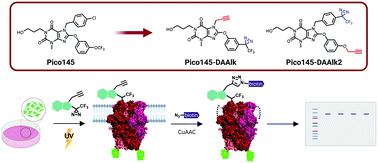当前位置:
X-MOL 学术
›
RSC Chem. Biol.
›
论文详情
Our official English website, www.x-mol.net, welcomes your feedback! (Note: you will need to create a separate account there.)
Xanthine-based photoaffinity probes allow assessment of ligand engagement by TRPC5 channels
RSC Chemical Biology Pub Date : 2020-09-18 , DOI: 10.1039/d0cb00126k Claudia C. Bauer 1, 2, 3, 4, 5 , Aisling Minard 1, 2, 3, 4, 5 , Isabelle B. Pickles 1, 2, 3, 4, 5 , Katie J. Simmons 1, 2, 3, 4, 5 , Eulashini Chuntharpursat-Bon 1, 2, 3, 4, 5 , Matthew P. Burnham 5, 6, 7, 8, 9 , Nikil Kapur 3, 4, 5, 10 , David J. Beech 1, 2, 3, 4, 5 , Stephen P. Muench 3, 4, 5, 11, 12 , Megan H. Wright 3, 4, 5, 13, 14 , Stuart L. Warriner 3, 4, 5, 13, 14 , Robin S. Bon 1, 2, 3, 4, 5
RSC Chemical Biology Pub Date : 2020-09-18 , DOI: 10.1039/d0cb00126k Claudia C. Bauer 1, 2, 3, 4, 5 , Aisling Minard 1, 2, 3, 4, 5 , Isabelle B. Pickles 1, 2, 3, 4, 5 , Katie J. Simmons 1, 2, 3, 4, 5 , Eulashini Chuntharpursat-Bon 1, 2, 3, 4, 5 , Matthew P. Burnham 5, 6, 7, 8, 9 , Nikil Kapur 3, 4, 5, 10 , David J. Beech 1, 2, 3, 4, 5 , Stephen P. Muench 3, 4, 5, 11, 12 , Megan H. Wright 3, 4, 5, 13, 14 , Stuart L. Warriner 3, 4, 5, 13, 14 , Robin S. Bon 1, 2, 3, 4, 5
Affiliation

|
TRPC1/4/5 cation channels are emerging drug targets for the treatment of, amongst others, central nervous system (CNS) disorders, kidney disease, and cardiovascular and metabolic disease. Various small-molecule TRPC1/4/5 modulators have been reported, including highly potent xanthine derivatives that distinguish between specific TRPC1/4/5 tetramers. However, tools to profile ligand engagement by TRPC1/4/5 channels in live cells are lacking. Here, we report a set of potent xanthine-based photoaffinity probes that functionally mimic the xanthines Pico145 and AM237. Using these probes, we have developed a photoaffinity labelling protocol for TRPC5 channels, providing the first method for the quantitative assessment of binding interactions of TRPC5 with small molecules in cells. This method could be important for drug discovery efforts targeting the xanthine/lipid binding site of TRPC1/4/5 channels.
中文翻译:

基于黄嘌呤的光亲和探针可评估TRPC5通道对配体的参与
TRPC1 / 4/5阳离子通道是新兴的药物靶点,可用于治疗中枢神经系统(CNS)疾病,肾脏疾病以及心血管和代谢性疾病。已经报道了各种小分子TRPC1 / 4/5调节剂,包括区分特定TRPC1 / 4/5四聚体的强力黄嘌呤衍生物。然而,缺乏用于通过活细胞中的TRPC1 / 4/5通道分析配体结合的工具。在这里,我们报告了一组功能强大的基于黄嘌呤的光亲和探针,这些探针在功能上模仿了黄嘌呤Pico145和AM237。使用这些探针,我们为TRPC5通道开发了光亲和标记方案,为定量评估TRPC5与细胞中小分子的结合相互作用提供了第一种方法。
更新日期:2020-11-03
中文翻译:

基于黄嘌呤的光亲和探针可评估TRPC5通道对配体的参与
TRPC1 / 4/5阳离子通道是新兴的药物靶点,可用于治疗中枢神经系统(CNS)疾病,肾脏疾病以及心血管和代谢性疾病。已经报道了各种小分子TRPC1 / 4/5调节剂,包括区分特定TRPC1 / 4/5四聚体的强力黄嘌呤衍生物。然而,缺乏用于通过活细胞中的TRPC1 / 4/5通道分析配体结合的工具。在这里,我们报告了一组功能强大的基于黄嘌呤的光亲和探针,这些探针在功能上模仿了黄嘌呤Pico145和AM237。使用这些探针,我们为TRPC5通道开发了光亲和标记方案,为定量评估TRPC5与细胞中小分子的结合相互作用提供了第一种方法。



























 京公网安备 11010802027423号
京公网安备 11010802027423号